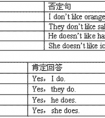按括号内的要求把下列句子变一变。1.You can find out about games on the computer.(对画线部分提问) _____________________________________________________________2.-五年级英语
题文
| 按括号内的要求把下列句子变一变。 |
| 1.You can find out about games on the computer.(对画线部分提问) _____________________________________________________________ 2.She had fish and chips.(改为否定句) ______________________________________________________________ 3.He taught Chinese five years ago.(改为一般疑问句) ____________________________________________________________________ 4.He read a book yesterday.(对画线部分提问) ___________________________________________________________________ 5.There is a bus in our city.(改为复数句子) __________________________________________________________________ |
答案
| 1. Where can you find out about games? 2. She didn't have fish and chips. 3. Did he teach Chinese five years ago? 4. What did he do yesterday? 5. There are many/lots of buses in our city. |
据专家权威分析,试题“按括号内的要求把下列句子变一变。1.You can find out about ga..”主要考查你对 there be 句型,否定句,一般疑问句,特殊疑问句 等考点的理解。关于这些考点的“档案”如下:
there be 句型否定句一般疑问句特殊疑问句
考点名称:there be 句型
- There be句型:
是英语中常用句型,意思是“有”,表示“人或事物的存在”。
There在此结构中是引导词,已经没有副词“那里”的含义。
There be后面的名词是句子的主语,属倒装结构。常用“There + be+名词+地点/时间状语”的结构。 - There be结构的用法:
A、肯定结构:
There be句型的肯定结构表示“某处存在某物或某人”或“某时发生某事”。
a. There is+单数可数名词/不可数名词+地点/时间状语。
例:There is a cat under the chair. 椅子下面有一只猫。
There is some water in the bottle. 瓶子里有些水。
b. There are +复数名词+地点/时间状语。
例:There are some apples in the basket. 篮子里有一些苹果。
B、否定结构:There be句型的否定结构是在谓语动词be的后面加“not (any)”或“no”.
例:There are no tables in the room. 或者There are not any tables in the room. 房间里没有桌子。
C、疑问结构:There be句型变成疑问式时,要把there和谓语动词be的位置互换。
例:Is there a pen in the schoolbag? 书包里有一支笔吗? - Therebe结构和have的区别与联系:
1.区别点:
there be 意为存在,强调某地有某物,不表示所属关系;
have 表示所有关系, 强调某人或某地有某物,这是其基本用法。如:
There are some trees in front of the house.房前有些树。
Tom has many friends in China.汤姆在中国有许多朋友。
2.相同点:
在表示结构上的含有时,既可以用there be 句型,也可以用have(has) 来表示。如:
中国有许多长河。
There are many long rivers in China.
China has many long rivers.
三月份有多少天?
How many days are there in March?
How many days has March? - There be结构中的be动词的确定:
A、there be 结构中的谓语动词be在人称和数上应与其后的主语保持一致。主语是不可数名词或单数可数名词时用is,是复数时用are。
例:There is a flower in the bottle. 瓶里有一朵花。
There is some money in the purse. 钱包里有些钱。
B、若句子中有几个并列的主语时,be的形式要与离其最近的一个主语在人称和数上保持一致。
例:There is a boy, a girl and two women in the house. 房子里有一个男孩,一个女孩和两个妇女。
There are ten students and a teacher in the office. 办公室里有十个学生和一个教师。
There be结构的句型转换:
A、否定句:
there be的否定式通常在be后加not构成(在口语中be时常与not缩写在一起)。如果句中有some,一般要变成any。 例:
There are some children in the picture.
There aren't any children in the picture.
B、一般疑问句及其答语:
把be提到there前,首字母大写,句末用问号即可。其肯定答语是Yes, there is / are;否定答语为No, there isn't / aren't。 例:
— Are there two cats in the tree?
— Yes, there are. (No, there aren't.)
C、特殊疑问句及其回答
a. 提问句子的主语(包括主语前的修饰语)时,句型一律用“what is+地点介词短语?”(无论主语是单数还是复数都用is)。
例:There are some birds in the tree. → What's in the tree?
b. 就there be后面的地点状语进行提问时,句型用“where is/ are+主语?”
例:There is a car in the street. → Where is the car?
c. 提问可数名词(主语)前的数量时,用how many,句型结构为“how many+ 复数名词+are there+其它)”(主语无论是单数还是复数,be通常要用are)。
例:There are three books on the desk. → How many books are there on the desk?
考点名称:否定句
- 否定句:
表示否定的句子。必须有否定词。
否定句的构成形式:
a. 谓语为be动词时,“be+not "一名学生。
b. 谓语为实义动词而且没有情态动词和助动词时,“do/ does/ did+not"构成否定。
例:I do not like dancing. 我不喜欢跳舞。
He does not want to go to school. 他不想去上学。
c. 谓语为“情态动词+实义动词”时,“情态动词+not”构成否定。
例:You must not smoke. 你千万不要吸烟。
I can not catch it. 我抓不住它。 - 否定句在英语语法中可以分为九类:
(1)一般否定句
I don't know this. No news is good news.
There is no person(smoking)/not a person/not any person(smoking)in the house.
(2)特指否定
He went to his office, not to see him.
I am sorry for not coming on time.
I don't think/believe/suppose/feel/imagine you are right.
(3)部分否定
All the answers are not right
All is not gold that glitters
I don't know all of them.
I can't see everybody/everything.
Both of them are not right.
(4)全体否定
None of my friends smoke.
I can see nothing/nobody.
Neither of them is right.
Nothing can be so simple as this.
(5)延续否定
You didn't see him, neither/nor did I.
You don't know, I don't know either.
He doesn't know English, let alone/to say nothing of/not to speak of(更不用说)French.
- 最新内容
- 相关内容
- 网友推荐
- 图文推荐
上一篇:There____three monkeys in the tree.[ ]A. isB.wasC.are-五年级英语
下一篇:There ______ a small river here many years ago.[ ]A. was B. isC. were-五年级英语
零零教育社区:论坛热帖子
| [家长教育] 孩子为什么会和父母感情疏离? (2019-07-14) |
| [教师分享] 给远方姐姐的一封信 (2018-11-07) |
| [教师分享] 伸缩门 (2018-11-07) |
| [教师分享] 回家乡 (2018-11-07) |
| [教师分享] 是风味也是人间 (2018-11-07) |
| [教师分享] 一句格言的启示 (2018-11-07) |
| [教师分享] 无规矩不成方圆 (2018-11-07) |
| [教师分享] 第十届全国教育名家论坛有感(二) (2018-11-07) |
| [教师分享] 贪玩的小狗 (2018-11-07) |
| [教师分享] 未命名文章 (2018-11-07) |




